Monogram 1/48 Typhoon IB
|
KIT #: |
? |
|
PRICE: |
$ 16.95 SRP |
|
DECALS: |
Two options |
|
REVIEWER: |
Tom Cleaver |
|
NOTES: |
Re-issue. Aeromaster decals |
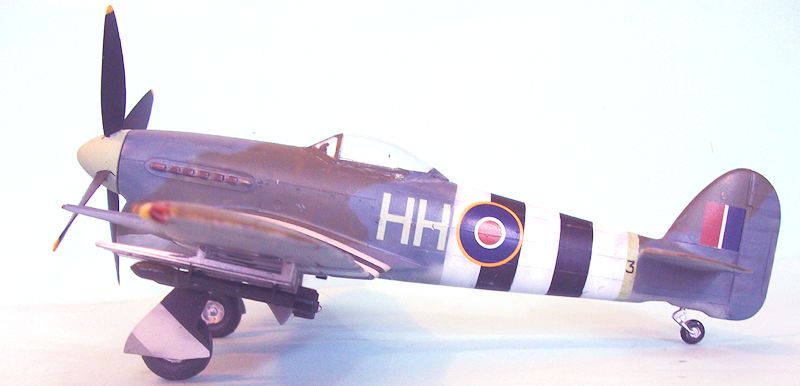
The Hawker
Typhoon appeared operationally in late 1942, and was used as a low altitude
fighter throughout 1943, with some development of the aircraft as a
fighter-bomber during that period.
In February, 1944, all Typhoon squadrons except 137
Squadron in Fighter Command were transferred to Second Tactical Air Force, the
RAF's contribution to the air support component of the upcoming invasion of
northern Europe.
The squadrons began training in earnest for the fighter-bomber
role, learning to use both the 60-lb RP and general purpose bombs.
The training was put to use over the Channel coast with
attacks on the V-1 launch sites under construction, and losses were not light at
low level under fire from the massive
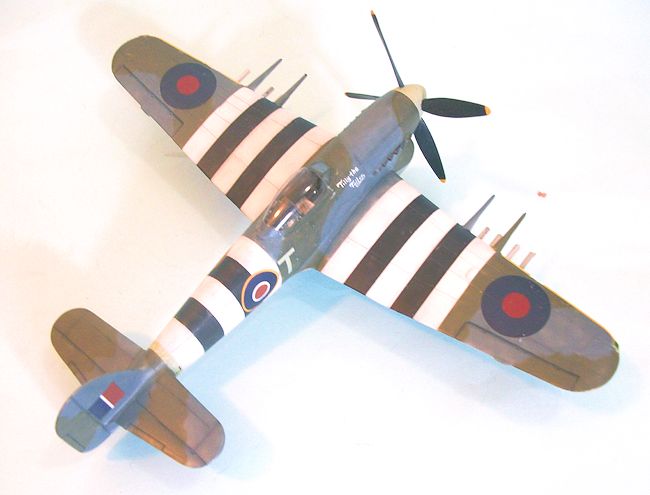 number of
light flak positions defending these sites.
number of
light flak positions defending these sites.
The first "bubbletop" Typhoon had appeared in September
1943.
The bubble canopy gave the Typhoon pilot the best all-round vision of
any fighter used by any combatant at the time, and its influence was seen within
six months with the introduction of the P-51D Mustang and later-production P-47D
Thunderbolt, both of which featured bubble canopies.
For the Typhoon squadrons, the slow delivery of this
modification in the basic airplane meant that bubbletops that reached the
squadrons were reserved for squadron and flight leaders.
The last "car-door" Typhoons did not leave first-line
service until March 1944.
In April and May 1944, a further modification was made
to the Typhoon, when the Tempest horizontal stabilizer and elevators were fitted
to the airplane.
The Tempest unit was only slightly larger in chord than the
original unit, but it provided increased stability, which had always been a
problem with the Typhoon design.
Generally, aircraft thus fitted were also fitted with
the Tempest 4-blade prop, but this was not always the case, and it is also
possible that aircraft with the original tail unit were fitted with the 4-blad
prop in the field.
On June 6, 1944, the Typhoon was the main RAF
fighter-bomber supporting the invasion.
By this stage, the system of forward air control that
had first begun in the North African campaign and had been honed in the Italian
campaign, insured that air support was able to be given as closely and
accurately as the weapons themselves would allow.
The Forward Air Controller, who was a pilot, was
equipped with a vehicle that had aircraft radios.
The controller could vector in fighter bombers by
telling them the ground features to look for that a pilot would notice.
The Typhoons patrolled the front lines in what was known
as "cab rank" formation, in which a flight would be called in by a controller,
execute and attack, and return to base for refueling and rearming, while other
flights were constantly overhead.
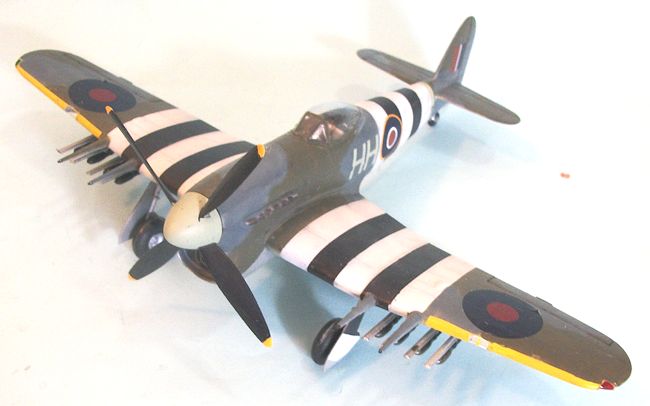 This system really came
into its own during the fighting in the Falaise Gap, following the American
breakthrough at St. Lo and the British victory around Caen in late July, which
meant the invasion forces could finally break out of the Norman bocage they had
been stuck in for nearly two months. While the Canadians swept southeast from
their breakthrough north of Caen, and Patton's Third Army lunged east after
cleaning up the Cotentin Peninsula, the two armies did not meet and trap all the
German forces they had been fighting.
Had the Falaise Gap been closed in early August 1944,
there would have been no German Army to have been rebuilt for the defense of the
homeland in the Fall of 1944, and the war in Europe likely would have ended
before New Years.
This system really came
into its own during the fighting in the Falaise Gap, following the American
breakthrough at St. Lo and the British victory around Caen in late July, which
meant the invasion forces could finally break out of the Norman bocage they had
been stuck in for nearly two months. While the Canadians swept southeast from
their breakthrough north of Caen, and Patton's Third Army lunged east after
cleaning up the Cotentin Peninsula, the two armies did not meet and trap all the
German forces they had been fighting.
Had the Falaise Gap been closed in early August 1944,
there would have been no German Army to have been rebuilt for the defense of the
homeland in the Fall of 1944, and the war in Europe likely would have ended
before New Years.
As it was, this 20 mile gap became a graveyard for the
mechanized units of the Wehrmacht, with the rocket-armed Typhoons of 2TAF
wreaking such carnage that in his book, "Wing Leader," British ace Johnny
Johnson commented that the stench of death was apparent as high as 7,000 feet
above the battlefield.
The Germans were so badly mauled that the Allied
leadership was convinced they would not be able to rebuild in time to hold at
the Rhine.
Unfortunately, the Allies could not restore Cherbourg or
any other harbor on the Channel coast, and were forced to continue bringing
supplies across the Normandy beachhead, which slowed the advance toward the R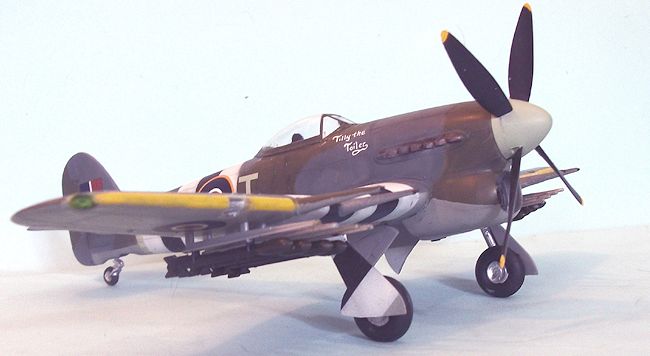 hine
following the liberation of Paris.
As a result, fuel shortages forced the Allies to choose
an advance through the German-French frontier lead by Patton's Third Army, or an
advance through the low countries led by Montgomery and the Commonwealth forces.
Patton was brought to a screeching halt when he could have punched through an
unmanned Siegfried line, and the story of "A Bridge Too Far" is well known.
hine
following the liberation of Paris.
As a result, fuel shortages forced the Allies to choose
an advance through the German-French frontier lead by Patton's Third Army, or an
advance through the low countries led by Montgomery and the Commonwealth forces.
Patton was brought to a screeching halt when he could have punched through an
unmanned Siegfried line, and the story of "A Bridge Too Far" is well known.
Regardless of the success of the overall strategy
dictating their use, the Typhoon as a rocket-armed airplane with the explosive
punch of a light cruiser became so successful that all memory of the troublesome
fighter of a year previously was forgotten.
Even tasked as fighter bombers and encumbered with
rocket rails and bomb racks, ten more Typhoon pilots became aces in the fighting
over Northwestern Europe, and five Typhoon aces from the pre-invasion fighting
added to their scores against the Luftwaffe.
According to the copyright stamped on the inside left
wing, this kit first appeared in 1967.
I don't it was immediately released, because I really
only remember people oohing and ahhing over it at the LHS in the fall of 1969.
Regardless, it is an old kit.
However, like the P-39 that definitely came out in 1969,
the Monogram Typhoon IB was among the most accurate kits of its generation.
The kit has been re-released with various decal options
several times in the 47 years since.
Imodeler.com is
having a D-Day Group Build, which I thought to participate in.
Imagine my surprise when I walked into the LHS and saw a
stack of new re-release kits, with a notice they were on sale for $9.99, a bit
more than half the current MSRP of $16.95.
Having not built one of these kits in over 20 years, I
decided 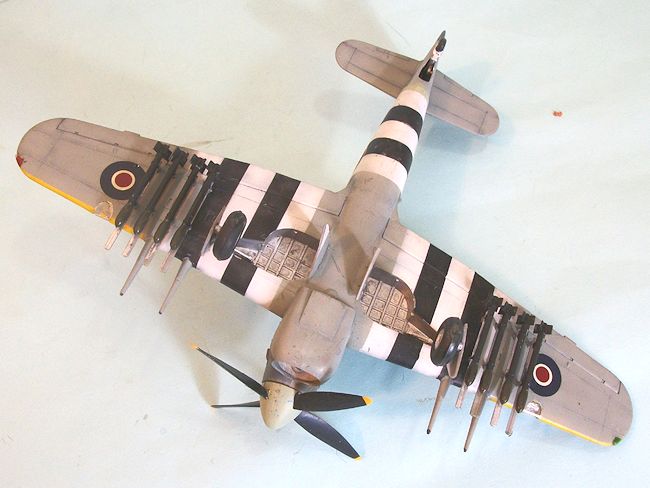 at
that price a stroll down memory lane would be a good idea.
at
that price a stroll down memory lane would be a good idea.
Most people consider that the Monogram kit was rendered
obsolete by the release of both cardoor and bubbletop Typhoons in 1/48 by
Hasegawa back in 2000-2001.
However, the fact that the Hasegawa kit hasn't been in
production for the past 6-7 years, and goes for around $50 when you can find
one, does change the equation.
The Monogram kit has the 4-blade Tempest prop and the
Tempest tailplanes of the later Typhoons, which the Hasegawa kit does not.
While the Monogram kit has a very simplified cockpit,
the fact is that the Typhoon cockpit isn't all that detailed and the later
bubbletop versions all had the cockpit painted black, which leaves not much to
be seen regardless.
The kit decals were never all that good as regards color
and overall quality, and that seems now to be a "tradition" with the kit, since
the decals here are not so great.
The national insignia are OK, but the fuselage decals,
which provide an option of wraparound D-Day stripes or stripes on the lower
fuselage only, include ID letters that look nothing like any I have seen in
photos in terms of the font and size, not to mention the attempt at providing
the "sky" color is way off the mark.
Fortunately, there were many sheets of decals for the
Typhoon released back when the Hasegawa kit came out, which can still be found
if you don't have them in your stash.
Construction of
the model definitely reveals its age.
The cockpit area consists of detail molded on the
fuselage interior sides, and a simplified floor, instrument panel and seat.
I put in some Evergreen rod to do the frame detail, and
upgraded the seat as well as scratchbuilt the floor.
All of that really went for naught
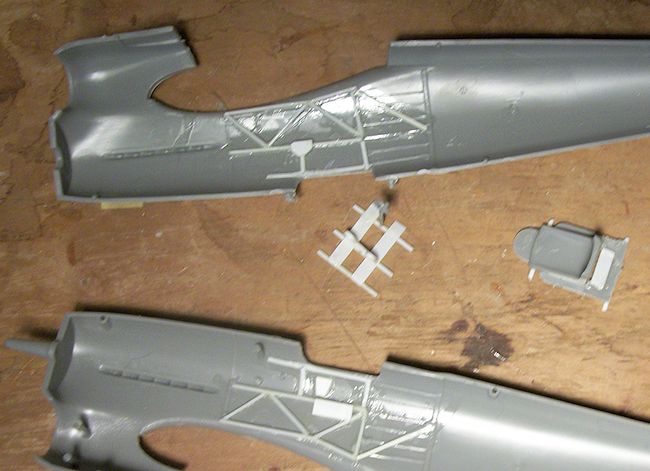 when the
cockpit was painted black, and the fact is one can easily get away with leaving
the cockpit alone and just hiding it with black paint.
when the
cockpit was painted black, and the fact is one can easily get away with leaving
the cockpit alone and just hiding it with black paint.
There is a huge
hole just ahead of the radiator when the fuselage is assembled.
I used some white glue to fill it, with excellent
results.
I also applied white glue around the edge of the rest of the radiator,
which closed things up.
White glue was also useful in closing up the open area
of the landing lights in the leading edges of the wings.
Remarkably, the
wing trailing edge is nice and sharp.
Fit of the wing subassembly to the fuselage subassembly
was nice and tight, and only required some Mr. Surfacer over the area where the
lower one-piece wing and fuselage come together.
I also applied Mr. Surfacer to the centerline seams of
the fuselage.
Once everything was sanded smooth, I lightly rescribed panel
lines over the raised lines.
Assembly of the model took a whole afternoon, working
slowly.
Having discovered
that I still had the Falcon vacuform Typhoon bubble canopy, I decided to use
that.
I filled in the area behind the cockpit that is dished out for the
injection canopy, and sanded that area smooth.
The Monogram canopy and the Falcon replacement are not
exactly right, both being a bit wider than the real thing.
However, closed up this way it isn't that obvious, and
the very clear Falcon canopy allows you to see as much of the cockpit as you
would were the canopy posed open.
I decided to do a Typhoon right at D-Day, with full
wraparound D-Day stripes on the wings and fuselage.
Right at the time of the invasion, most squadrons
completely overpainted any ID letters on the fuselage, as well as overpainting
the serial number.
I first preshaded the model and applied black for the
stripes, then masked them off and applied white.
Using thinned flat white and doing it this way results
in the white getting a "temporary" look.
I masked off the D-Day markings, then painted the sky
band on the f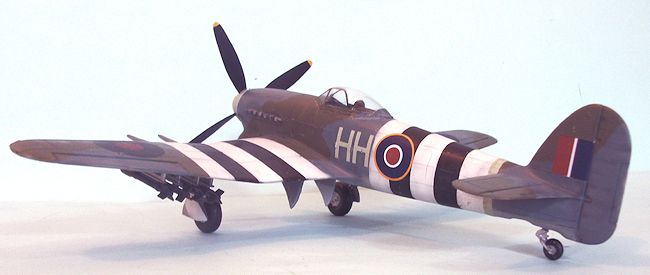 uselage
and the yellow wing leading edges, and masked them off.
I used Tamiya "Ocean Grey," "RAF Dark Green" and "Sea
Grey Medium" for the camouflage.
uselage
and the yellow wing leading edges, and masked them off.
I used Tamiya "Ocean Grey," "RAF Dark Green" and "Sea
Grey Medium" for the camouflage.
With the
wraparound D-Day stripes, I didn't have to worry about all the ID letters and
serial, since these were overpainted.
This made it easy to use decals from a cut-up Aeromaster
sheet, and I did an airplane from 174 Squadron.
The kit decals were used for the national insignia
without problem.
I gave the model an overall coat of Xtracxrylix Clear
Flat, then unmasked the canopy.
I then attached the landing gear and the prop.
The rocket tails are incorrect, being molded
vertical/horizontal due to the production technology of the time.
I cut off the tails and used tails from rockets in an
Airfix Seafire kit.
The Monogram
Typhoon stands the test of time.
It makes up into an accurate model without a lot of fuss
and bother.
If you have the Falcon cardoor canopy, it isn't that hard to
modify the kit to turn it into the earlier version.
It assembles easily, and can sit next to Hasegawa
Typhoons without looking bad at all.
And even if you pay the modern MSRP, that still means
you could buy three of them for one Hasegawa kit.
Tom Cleaver
March 2014
Review kit courtesy of my wallet.
If you would like your product reviewed fairly and fairly quickly, please
contact the editor or see other details in the
Note to
Contributors.
Back to the Main Page
Back to the Review Index Page


 number of
light flak positions defending these sites.
number of
light flak positions defending these sites. 
 hine
following the liberation of Paris.
As a result, fuel shortages forced the Allies to choose
an advance through the German-French frontier lead by Patton's Third Army, or an
advance through the low countries led by Montgomery and the Commonwealth forces.
Patton was brought to a screeching halt when he could have punched through an
unmanned Siegfried line, and the story of "A Bridge Too Far" is well known.
hine
following the liberation of Paris.
As a result, fuel shortages forced the Allies to choose
an advance through the German-French frontier lead by Patton's Third Army, or an
advance through the low countries led by Montgomery and the Commonwealth forces.
Patton was brought to a screeching halt when he could have punched through an
unmanned Siegfried line, and the story of "A Bridge Too Far" is well known.
 at
that price a stroll down memory lane would be a good idea.
at
that price a stroll down memory lane would be a good idea. when the
cockpit was painted black, and the fact is one can easily get away with leaving
the cockpit alone and just hiding it with black paint.
when the
cockpit was painted black, and the fact is one can easily get away with leaving
the cockpit alone and just hiding it with black paint. uselage
and the yellow wing leading edges, and masked them off.
I used Tamiya "Ocean Grey," "RAF Dark Green" and "Sea
Grey Medium" for the camouflage.
uselage
and the yellow wing leading edges, and masked them off.
I used Tamiya "Ocean Grey," "RAF Dark Green" and "Sea
Grey Medium" for the camouflage.